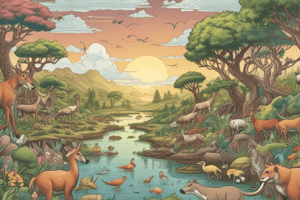Podcast
Questions and Answers
What distinguishes an open system from a closed system in an ecosystem?
What distinguishes an open system from a closed system in an ecosystem?
- Energy can enter, but matter cannot in both systems.
- Matter can enter and exit in both systems.
- Energy and matter can enter and exit in an open system, but not in a closed system. (correct)
- Energy can enter and exit, while matter can only exit.
Which organisms are primary producers in ecosystems that primarily rely on photosynthesis?
Which organisms are primary producers in ecosystems that primarily rely on photosynthesis?
- Cyanobacteria and eukaryotic algae (correct)
- Secondary consumers and tertiary consumers
- Carnivores that feed on herbivores
- Decomposers and detritivores
What role do decomposers play in an ecosystem?
What role do decomposers play in an ecosystem?
- They recycle nutrients by breaking down dead organic matter. (correct)
- They are primary consumers that feed on producers.
- They are responsible for primary production through photosynthesis.
- They act as the final consumers in a food chain.
In a food chain, which trophic level is represented by organisms that feed on primary producers?
In a food chain, which trophic level is represented by organisms that feed on primary producers?
Which of the following statements is true about autotrophs?
Which of the following statements is true about autotrophs?
What is the primary reason for the restriction on the number of trophic levels in an ecosystem?
What is the primary reason for the restriction on the number of trophic levels in an ecosystem?
What is the primary energy source for ecosystems that are located in open caves?
What is the primary energy source for ecosystems that are located in open caves?
Which option correctly defines 'saprotrophs'?
Which option correctly defines 'saprotrophs'?
Which term describes the total biomass of carbon compounds created during photosynthesis?
Which term describes the total biomass of carbon compounds created during photosynthesis?
How many kilojoules per square meter per year are usually lost at each step of a trophic level?
How many kilojoules per square meter per year are usually lost at each step of a trophic level?
What is the relationship between primary producers and secondary consumers in terms of biomass?
What is the relationship between primary producers and secondary consumers in terms of biomass?
Why might adopting more plant-based diets increase overall productivity in ecosystems?
Why might adopting more plant-based diets increase overall productivity in ecosystems?
What is the primary role of photoautotrophs in an ecosystem?
What is the primary role of photoautotrophs in an ecosystem?
Which process is specifically associated with heterotrophs?
Which process is specifically associated with heterotrophs?
How is oxidation defined in biological processes?
How is oxidation defined in biological processes?
What is the significance of the 10% Rule in energy pyramids?
What is the significance of the 10% Rule in energy pyramids?
Which statement best describes the energy loss in food chains?
Which statement best describes the energy loss in food chains?
In the context of trophic levels, what distinguishes primary producers from consumers?
In the context of trophic levels, what distinguishes primary producers from consumers?
What kind of organisms utilize oxidation reactions to harness energy directly from their environment?
What kind of organisms utilize oxidation reactions to harness energy directly from their environment?
What term describes organisms that derive their carbon from consuming others?
What term describes organisms that derive their carbon from consuming others?
What process do photoautotrophs primarily use for energy conversion?
What process do photoautotrophs primarily use for energy conversion?
What is the most significant factor limiting the number of trophic levels in a food chain?
What is the most significant factor limiting the number of trophic levels in a food chain?
What is indicated by a carbon sink in an ecosystem?
What is indicated by a carbon sink in an ecosystem?
Which process primarily contributes to the net release of carbon in an ecosystem?
Which process primarily contributes to the net release of carbon in an ecosystem?
What is the primary flux that drives the carbon cycle in ecosystems?
What is the primary flux that drives the carbon cycle in ecosystems?
How can ecosystems act as carbon sources?
How can ecosystems act as carbon sources?
Which of the following best describes 'flux' in carbon cycling?
Which of the following best describes 'flux' in carbon cycling?
Which process is significantly influenced by decomposition rates in an ecosystem?
Which process is significantly influenced by decomposition rates in an ecosystem?
What is a primary factor that differentiates carbon sources from carbon sinks?
What is a primary factor that differentiates carbon sources from carbon sinks?
Which of the following processes involves the conversion of organic matter into fossil fuels?
Which of the following processes involves the conversion of organic matter into fossil fuels?
Which condition can enhance carbon storage in an ecosystem?
Which condition can enhance carbon storage in an ecosystem?
Which statement is true regarding carbon cycling in ecosystems?
Which statement is true regarding carbon cycling in ecosystems?
What is a carbon sink created through fossilization?
What is a carbon sink created through fossilization?
What process is responsible for the release of carbon dioxide into the atmosphere?
What process is responsible for the release of carbon dioxide into the atmosphere?
Which factor is necessary for atmospheric carbon dioxide levels to remain constant?
Which factor is necessary for atmospheric carbon dioxide levels to remain constant?
What is currently happening to carbon release and uptake rates?
What is currently happening to carbon release and uptake rates?
What is the primary source of carbon dioxide emissions during combustion?
What is the primary source of carbon dioxide emissions during combustion?
Which of the following contributes to the formation of peat, coal, and natural gas?
Which of the following contributes to the formation of peat, coal, and natural gas?
What happens to dead organic matter in relation to carbon cycling?
What happens to dead organic matter in relation to carbon cycling?
Which of the following describes the role of carbon sources?
Which of the following describes the role of carbon sources?
What is the consequence of an imbalance between carbon release and uptake in sinks?
What is the consequence of an imbalance between carbon release and uptake in sinks?
How does burning fossil fuels primarily affect atmospheric carbon levels?
How does burning fossil fuels primarily affect atmospheric carbon levels?
Flashcards are hidden until you start studying
Study Notes
Ecosystems as Open Systems
- Ecosystems are open systems where both energy and matter can enter and exit.
- Ecosystems are a collection of all the living organisms (biotic) and non-living components (abiotic) in an area.
Sunlight as the Principal Energy Source
- Sunlight is the primary source of energy for most ecosystems.
- Producers convert solar energy into chemical energy through photosynthesis.
- Producers include cyanobacteria, plants, and eukaryotic algae.
- Light intensity and absorption by producers vary depending on global positions or depths in aquatic environments.
- In some environments, like closed caves, chemosynthetic bacteria use energy from chemical reactions.
Flow of Energy Through Food Chains
- Food chains represent feeding relationships in an ecosystem, starting with producers.
- Arrows in a food chain symbolize the flow of energy.
- The last organism in a food chain has no predators.
Food Webs
- Food webs illustrate all possible food chains within a community.
- Organisms are categorized into trophic levels: primary producers, primary consumers, secondary consumers, and tertiary consumers.
Decomposers and Energy Supply
- Decomposers obtain energy from dead organisms, waste products, and feces.
- They play a crucial role in nutrient recycling.
- Saprotrophs - Decomposers that digest externally.
- Detritivores - Decomposers that digest internally.
Autotrophs
- Autotrophs synthesize all necessary carbon compounds from inorganic substances.
- Examples include plants, algae, and cyanobacteria.
Energy Sources for Autotrophs
- Autotrophs require energy to convert inorganic substances into organic compounds.
- Photoautotrophs utilize sunlight as their energy source.
- Chemoautotrophs use energy from oxidation reactions.
- Oxidation reactions release energy, like when iron is oxidized in the presence of air.
- Chemoautotrophs harness energy from oxidation reactions, similar to ATP production during cellular respiration.
Heterotrophs
- Heterotrophs obtain carbon compounds (and energy) by consuming other organisms.
- They use digestion to break down molecules for absorption and synthesis of new compounds.
- Digestion can be internal (consuming, digesting, absorbing, and synthesizing) or external (releasing enzymes, digesting, absorbing, and synthesizing).
Energy Release in Autotrophs and Heterotrophs
- All organisms require ATP.
- ATP is produced during cellular respiration.
- Cellular respiration involves oxidizing carbon compounds to release energy and produce ATP.
- Autotrophs create and oxidize their own carbon compounds.
- Heterotrophs oxidize carbon compounds obtained from their food.
Trophic Levels
- Trophic levels are based on an organism's position in a food chain.
Energy Pyramids
- Energy pyramids represent the amount of energy gained per year per unit of area at each trophic level.
- The 10% Rule states that only approximately 10% of energy is transferred to the next trophic level.
- Energy pyramids are proportionally stepped, not triangular.
Energy Loss Between Trophic Levels
- About 90% of energy is lost between trophic levels due to:
- Cellular respiration (heat loss from oxidizing carbon compounds)
- Incomplete consumption (not all parts of an organism are eaten)
- Incomplete digestion (not all parts are digestible)
Heat Loss During Respiration
- Cellular respiration produces heat as a byproduct of energy conversion.
- Heat is lost to the environment and cannot be converted back into chemical energy.
Trophic Level Limitations
- Energy loss limits the number of trophic levels in an ecosystem.
- Longer food chains have more energy loss and limited biomass at higher levels.
Primary Production
- Primary production represents the accumulation of carbon compounds in biomass by producers.
- Gross Primary Production (GPP) is the total biomass produced during photosynthesis.
- Net Primary Production (NPP) is the available biomass to consumers after accounting for plant respiration.
- Different biomes have varying production capacities.
Secondary Production
- Secondary production refers to the accumulation of carbon compounds in biomass by heterotrophs.
- Secondary production decreases with each trophic level due to reduced oxidizable carbon compounds.
- Increasing plant-based diets can enhance productivity.
Carbon Cycling
- Pools are reserves or storage places for certain elements.
- Fluxes are the transfers of elements from one pool to another.
- Ecosystems are open, meaning they can gain and lose matter and energy.
- Photosynthesis and respiration are the main fluxes in the carbon cycle.
- Carbon sinks are ecosystems that have a net uptake of carbon, where photosynthesis exceeds respiration.
- Carbon sources are ecosystems that have a net release of carbon, where respiration exceeds photosynthesis.
- Factors that can influence the carbon sink/source status of an ecosystem include decomposition rates, biosequestration, fires, etc.
Release of Carbon Dioxide
- Burning biomass, peat, coal, oil, and natural gas releases carbon dioxide into the atmosphere.
- Fossilization creates a carbon sink in the form of peat, coal, and natural gas.
- Combustion of these fossil fuels releases carbon back into the atmosphere.
- For atmospheric carbon dioxide levels to remain constant, uptake in sinks needs to be equal to release from sources.
- Currently, the release of carbon from sources is outpacing the uptake by sinks.
Studying That Suits You
Use AI to generate personalized quizzes and flashcards to suit your learning preferences.




